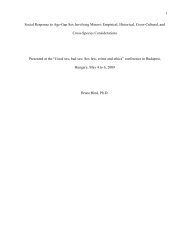Infant and Child Sexuality: A Sociological Perspective - Ipce
Infant and Child Sexuality: A Sociological Perspective - Ipce
Infant and Child Sexuality: A Sociological Perspective - Ipce
You also want an ePaper? Increase the reach of your titles
YUMPU automatically turns print PDFs into web optimized ePapers that Google loves.
experienced by putting them in the mouth, by sucking, by touching,<br />
eating, <strong>and</strong> biting. This basically auto-erotic stage lasts for the<br />
first five or six months of life. (Hurlock, 1950, p. 485). Yet, from as<br />
early as two months of age onward <strong>and</strong> increasingly through the first<br />
year of life, infants are not so much passive <strong>and</strong> receptive as active<br />
in seeking interaction. The majority of infants provide evidence of the<br />
need for the proximity of others sometime during the first quarter of<br />
the first year. (Ainsworth, 1963).<br />
Attachment is a two way process. Attachment behavior between mother<br />
<strong>and</strong> infant is behavior through which a relationship is established that<br />
initiates a chain of interaction which serves to consolidate the<br />
affectional relationship. In studying interaction of twenty-eight<br />
babies with their mothers Ainsworth (1964) catalogued thirteen patterns<br />
of attachment besides those associated with feeding--the rooting<br />
response, sucking, <strong>and</strong> search for the breast. From the infant’s side,<br />
the thirteen include differential crying, smiling <strong>and</strong> vocalizing,<br />
visual-motor orientation, crying when the mother left, following,<br />
scrambling, burying the face, exploring from a secure base, clinging,<br />
lifting the arms <strong>and</strong> clapping the h<strong>and</strong>s in greeting, <strong>and</strong> approach<br />
through locomotion.<br />
Preference for the mother is not present at birth; it must develop<br />
out of the feeding <strong>and</strong> caring experience. The infant’s earliest posture<br />
is one of undiscriminating responsiveness. In the first few weeks of<br />
life it can be assumed that the infant experiences the mother, <strong>and</strong><br />
particularly her breast, as part of himself. (Spitz, 1962). The first<br />
few weeks of life can be characterized as an around the clock time of<br />
sleep alternating with waking periods in which the infant’s contact<br />
with the mother is dictated by hunger rather than by any other drive or<br />
appetite. But the mother <strong>and</strong> the infant are two independent<br />
psychophysiological systems. They interact through specific mechanisms<br />
of stimulation <strong>and</strong> pacification. (Segal, 1971, p. 203). And in the<br />
process circular social interaction becomes more discriminating <strong>and</strong> the<br />
relations between the two become numberless <strong>and</strong> infinitely varied.<br />
(Spitz, 1962).<br />
Most mothers in the nuclear family common to the United States do<br />
not share the intimate care of their offspring with another adult<br />
(although more <strong>and</strong> more fathers are becoming involved) <strong>and</strong> are in a<br />
position to develop an unusually close relationship with their baby.<br />
Caldwell <strong>and</strong> Hersher (1964) found that such mothers, in contrast to<br />
mothers who shared care of the infant with others, were less<br />
intellectualized in their relationships with the baby, were more<br />
sensuous in their touching <strong>and</strong> h<strong>and</strong>ling, were more likely to vocalize,<br />
were more active, <strong>and</strong> more playful with their babies of six months of<br />
age. At one year of age they were rated as more dependent upon their<br />
babies for the achievement of their own need gratifications. In<br />
general, the data suggests a slightly comfortable <strong>and</strong> involved<br />
relationship between infant <strong>and</strong> mother in the cases where the mother<br />
had exclusive responsibility for the child care role.<br />
<strong>Infant</strong>s show differing personality traits, strengths in their aggressive<br />
instincts for example. Some are placid. Some are quiet. Some<br />
are noisy <strong>and</strong> active. These temperaments stay with them as they grow.<br />
(Finch, 1969). There are also male-female behavioral differences<br />
present at birth, though research findings are as yet few in number.<br />
9
















